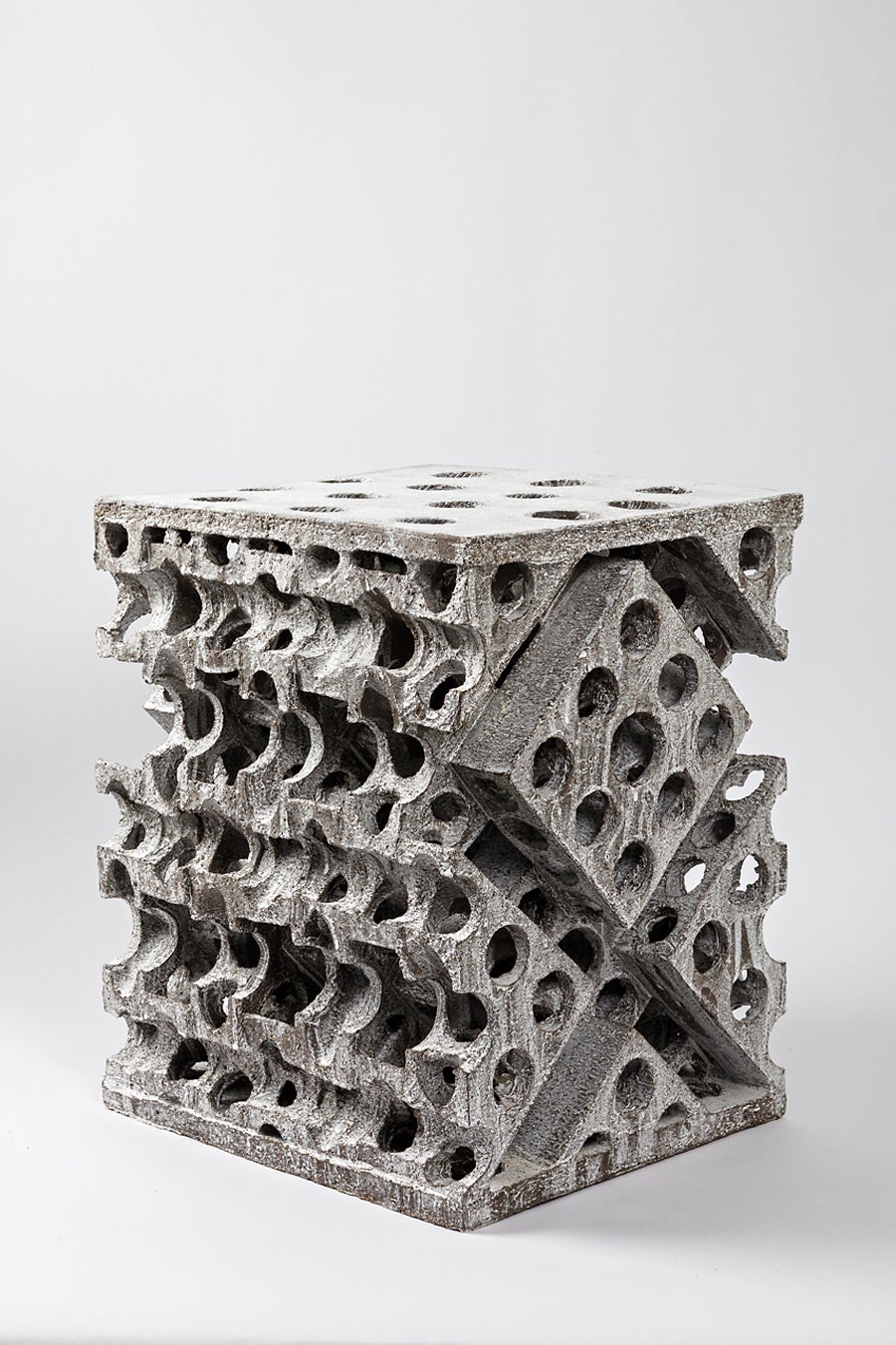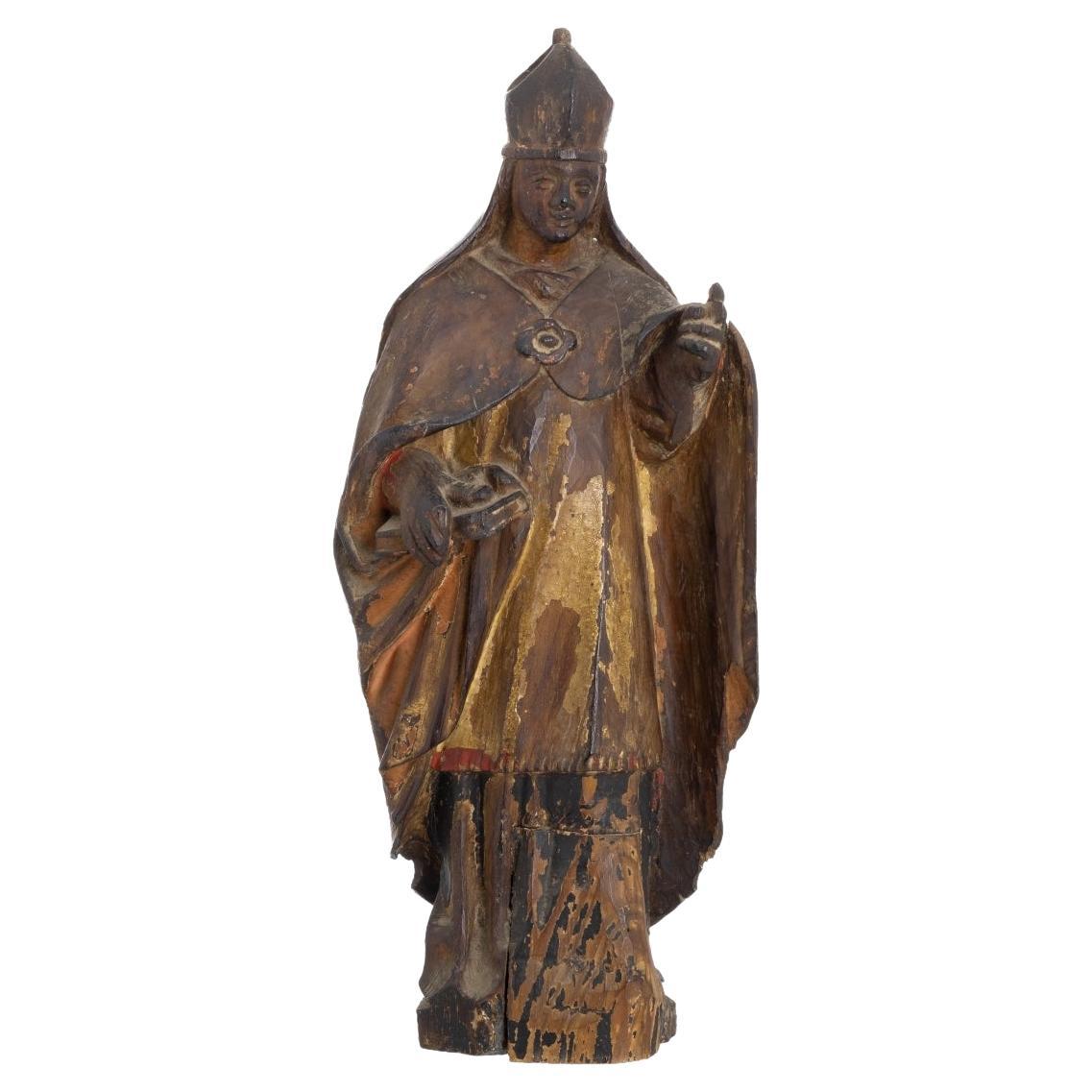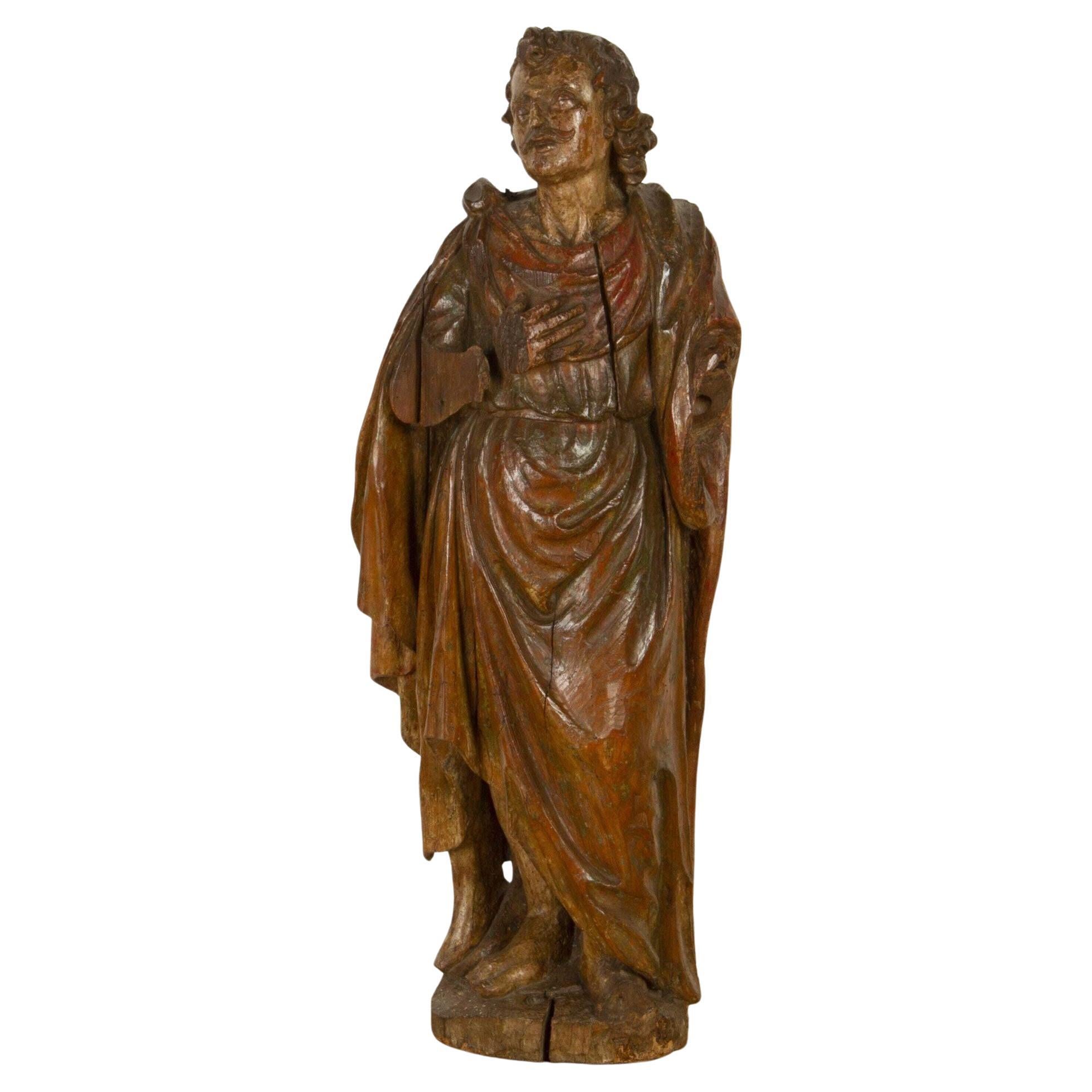Items Similar to Saint Florian
Want more images or videos?
Request additional images or videos from the seller
1 of 7
Saint Florian
About the Item
SAINT FLORIAN
ORIGIN: SOUTH GERMANY, SWABIA
PERIOD: END OF THE 15th CENTURY
Height : 100,5 cm
Width : 34 cm
Depth : 17 cm
Polychromed lime wood
Good state of conservation
Since the Middle Ages, Saint Florian has been the object of an important popular cult in Austria, especially in the Tyrol, but also in Bavaria and Bohemia. A symbol of courage and determination, he was invoked to protect the souls of the living from sin and those of the dead from the torments of purgatory.
From the middle of the 15th century onwards, he protected against the dangers of water and fire. It was said that, as a young man, he had put out a church fire with a simple jug of water and saved a coalman from the flames who had fallen into a flaming millstone.
This evolution of the cult of Saint Florian was also noticeable in the arts. For a long time, he was represented as the conqueror of death, covered in his armour, with a sword in his fist, but from the middle of the 15th century, still wearing armour, he is watering a burning house with a jug or a bucket.
It is to this second iconographic type that this beautiful Florian saint belongs. With a relatively elongated barrel, it is fashioned from a monoxyl limewood log. Florian is depicted in a half round shape, the back being largely hollowed out. The beautiful original polychromy is particularly well preserved.
The legionary saint is standing and holding a bucket of water, with which he is pouring water over a fortified house that is being consumed by flames. The young saint's beardless face is framed by curly hair. A small cap with a rolled-up brim covers his head.
Saint Florian's face, with its fine and delicate features, is slightly tilted to the right. His two eyes, with half-closed lids, appear under the arch of the eyebrows, which are sketched with a simple black line with a well-defined curve. Slightly drooping, they seem to indicate a form of resignation or melancholy.
The Saint's reserved face and inward expression are contrasted with the very elegant workmanship of the gilded cloak with green reverse. The cloak, which is placed on his shoulders, reveals the armour of Saint Florian, the breastplate of which can be seen. One side of the cloak on the front of his body forms deep, rounded folds.
On his feet, he is wearing bear's paw shoes.
This sculpture is similar in iconography and style to the production of the South German workshops of the late 15th century
Indeed, from around 1475 to 1530, South German sculpture enjoyed great creativity, becoming a particularly dynamic centre of production. This art, often referred to as "late Gothic", was characterised by the softness and reserved sensitivity of its figures, the importance of detail and the virtuoso work of drapery.
Production was dominated by wood carving. The lime tree distinguishes the production of this region. This soft, light wood gave the carver a great deal of freedom and allowed for a fine rendering and a beautiful polish. Usually carved from a single block of wood, the sculpture is worked horizontally, placed on a large lathe so that the carver can turn it as he wishes. Certain more complex or difficult to access elements were worked separately before being assembled to the sculpture, which was probably the case for the bucket of our Saint Florian, the heart of the log in order to preserve the sculpture from cracks that could appear during the drying of the wood. This also made it possible to reduce the volume and total weight of the sculpture.
As the sculpture of the Florian saint illustrates, polychromy was of primary importance and was never neglected. The use of gilding, typical of the late Middle Ages, contributes to the richness of these sculptures. The polychromy gives Saint Florian a tangible reality thanks to the rendering of the materials while recalling his sacred character, through the preciousness of the materials and the brilliance of the gold.
The details of the costume are characteristic of the realism of the artists of this region in the last decades of the 15th century, bearing the imprint of the art of Hans Multscher, who worked in Ulm between the years 1430-1467. His flourishing workshop made a lasting impression on the generations that followed him throughout Swabia.
Thus, this Saint Florian appears to be a very fine work from a South German workshop, late 15th century.
Hagiography of Saint Florian
According to the account of the Passion of Saint Florian, he was martyred in the year 304. This year was marked by the persecution of soldiers who had embraced the Christian faith by the Roman emperor Diocletian.
On hearing of the imprisonment of forty Christians in Lauriacum (Lorch, Austria), Saint Florian, a former Roman legionary, went before the prefect Aquilinus. Not giving in to the violence or anger of the latter, Saint Florian did not deny his faith and refused to sacrifice to the gods. Aquilinus then ordered that he be thrown into the waters of the Enns with a millstone around his neck. Some time later, the mortal remains of the poor Saint washed up on the rocks. It was watched over by an eagle before a pious widow named Valerie secretly gave it a more dignified burial.
An Augustinian monastery was built on the presumed site of his grave in 1071 - today in the town of Sankt Florian, 13 km from Linz - and has been rebuilt several times over the centuries. In the crypt of the abbey church a stone millstone is preserved, which is said to have been used for the martyrdom of St Florian. A pilgrimage soon developed here.
The dispersal of the saint's relics to Italy and Poland (of which he is a patron saint) enabled his cult to spread beyond Austria. However, it was in Austria and southern Germany that it was most prevalent.
He was the first Austrian martyr and the first Austrian saint to be canonised.
Bibliographie
Claude Lapaire, Sculpture sur bois du Moyen-âge, Genève : Musée d’art et d’histoire, 1986
Coll., Sculpture allemande de la fin du Moyen-âge dans les collections publiques françaises : 1400-1530, Musée du Louvre, 1991
Michael Baxandall, South German Sculpture, 1480-1530, Victoria and Albert Museum, 1974
Sophie Guillot de Suduiraut, Sculptures médiévales allemandes, conservation et restauration, La Documentation française, 1993
Sophie Guillot de Suduiraut, Dévotion et séduction, Sculptures souabes des musées de France vers 1460-1530, Somogy, 2015
- Dimensions:Height: 39.57 in (100.5 cm)Width: 13.39 in (34 cm)Depth: 6.7 in (17 cm)
- Style:Gothic (Of the Period)
- Materials and Techniques:
- Place of Origin:
- Period:
- Date of Manufacture:End of 15th century
- Condition:Wear consistent with age and use.
- Seller Location:Saint-Ouen, FR
- Reference Number:1stDibs: LU3115338004282

About the Seller
5.0
Vetted Seller
These experienced sellers undergo a comprehensive evaluation by our team of in-house experts.
Established in 2016
1stDibs seller since 2017
151 sales on 1stDibs
Typical response time: 7 hours
- ShippingRetrieving quote...Ships From: Paris, France
- Return PolicyThis item cannot be returned.
More From This SellerView All
- Carved Polychrome Wood Depicting Saint FlorianLocated in Saint-Ouen, FRCARVED POLYCHROME WOOD DEPICTING SAINT FLORIAN ORIGIN : SWABIA, SOUTHERN GERMANY PERIOD : LATE 15th CENTURY Height : 98 cm Length : 29 cm Depth : 24 cm Polychrome limewood Very fi...Category
Antique 15th Century and Earlier Figurative Sculptures
MaterialsWood
- Saint Woman in polychrome carved woodLocated in Saint-Ouen, FRSAINT WOMAN IN POLYCHROME CARVED WOOD ORIGIN : ITALY PERIOD : late 13th century Height : 103 cm Length : 28 cm Width : 16 cm Remains of polychromy ...Category
Antique 15th Century and Earlier Italian Gothic Figurative Sculptures
MaterialsSoftwood
- 15th Century Carved Wood Depicting Saint JamesLocated in Saint-Ouen, FRThe Saint depicted here is Saint James the Great. James is the brother of St. John the Evangelist. Nothing is known of his activities after the Ascension...Category
Antique 15th Century and Earlier French Gothic Figurative Sculptures
MaterialsOak
- 13th Century Virgin and Child from CataloniaLocated in Saint-Ouen, FRSeating on a bench-like throne the Virgin carries her child on her left knee. She bears an important crown high on her head .The Virgin has an ovoid face with bulging eyes, straight long nose and thin lips. The hair parts in the middle and are carved as thick horizontals parallel hair strands...Category
Antique 15th Century and Earlier Spanish Gothic Figurative Sculptures
MaterialsOak
- Element of an Outdoor Carved Woodwork Showing a Salamander from a Normand HouseLocated in Saint-Ouen, FRThis carved oak woodwork was probably placed on the facade of the house, close to the roofing framework of a Norman house. The sculptor had depicted the salamender frontview in a sty...Category
Antique 16th Century French Gothic Statues
MaterialsOak
- Gothic Virgin and Child with a PhylacteryLocated in Saint-Ouen, FRThis Virgin and Child is wearing clothes with a limited number of folds and showing a thickness characteristic of the Burgundy region. As a result of the presence in the region of th...Category
Antique 15th Century and Earlier French Gothic Figurative Sculptures
MaterialsWalnut
You May Also Like
- Wonderful 17th Century Oak Statue of Saint Florian, Patron Saint of FirefightersLocated in Dallas, TXSt. Florian (250 A.D. – 304 A.D.), was the patron saint of firefighters, brewers, chimney sweeps, and the town of Linz Austria. He served in the Roman army and part of his duties included organizing fire fighting brigades. He was secretly a Christian and became famous for miraculously saving a town from being destroyed by fire; after he prayed and threw a single bucket of water on the blaze, it was extinguished. This beautifully carved oak statue from the 1600s, clearly depicts St. Florian with a bucket in hand and a miniature house...Category
Antique 17th Century French Figurative Sculptures
MaterialsOak
- Saint Ambrosius Italian Sculpture 17th CenturyBy Europa AntiquesLocated in Madrid, ESSaint Ambrosius Italian sculpture 17th century in painted and gilded wood. The figure is represented standing up blessing with the hand. Faults and defects. Dimensions. Heigh...Category
Antique Mid-17th Century Italian Gothic Figurative Sculptures
MaterialsWood
- 17th Century Carved Figure of a SaintLocated in Gloucestershire, GBMid 17th century Northern European carved figure of a saint. This striking statue depicts a saint who is dressed in robes, whilst holding his hand over his heart. This figure is freestanding and is stood within a leaning position which makes him stand out. It has been beautifully carved from oak and has remnants of its original paintwork. Likely to have stood within a church for many years and would have been removed due to renovation reasons. This historical figure...Category
Antique 17th Century German Gothic Figurative Sculptures
MaterialsOak, Paint
- Pair of 16th Century Carved Oak SaintsLocated in Maidstone, GBA Pair of 16th Century Oak Saints: One being a male depicted wearing a long hooded cloak held together with a brooch over a flowing tunic tied at the ...Category
Antique 16th Century European Gothic Figurative Sculptures
MaterialsOak
- 16th Century French Oak Polychrome Statue of Saint MaudezLocated in San Francisco, CA16th century French oak polychrome statue of Saint Maudez. A Breton saint from the 5th-6th century who founded a monastery off the coast of Brittany. Saint Maudez was said to have ba...Category
Antique 16th Century French Gothic Figurative Sculptures
MaterialsGesso, Oak
- 19th Century Italian Alabaster Carved Head Of A Bishop SaintLocated in Stamford, CT19th century Italian carved alabaster head of a saint wearing a bishop's mitre in the Gothic style. Though a fragment, the intense gaze of this small carving gives it a lot of presence. Rendered by a master carver, this piece has a lot of personality. Likely an architectural fragment, the weathered surface and distressed condition only add to the appeal of this unique sculpture. Mounted on an ebonized walnut base. 10 inches high 3.5 square 5 7/8 inches high by 4 wide by 3.75 deep (head only)Category
Antique Early 19th Century Italian Gothic Busts
MaterialsAlabaster
Recently Viewed
View AllMore Ways To Browse
Carved Stone Finials
Saint Florian
Chest Pain Chest
Bather Statue
Art Nouveau Bronze Ewer
Paris Metropolitain
Yoruba Bronze Head
Cherubs Marble Base
3 Sculpture
Bronze Sculpture Mcm
Cloak Pin
Unknown Dmk
Goddess Model
Milwaukee Chair
Diana Huntress Sculpture
Louis Philippe Salon
Victorious Antique
Victorious Antiques





